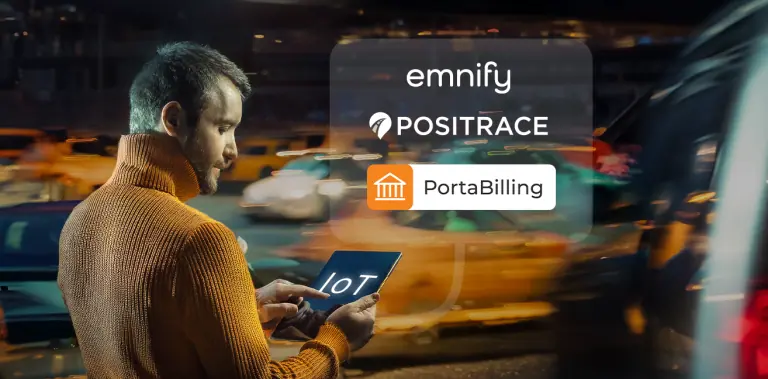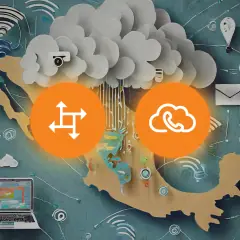For this webinar, PortaOne brings together experts from the worlds of telecom, IoT, and M2M to discuss how service providers can profit from the growing demand for fleet management tools. Klaus Haertel, director of strategic alliances with PortaOne, joins Aleksandr Mazalov and Bill Kornilo from PosiTrace and Adriano De Santis from emnify to share their expertise on how businesses can effectively leverage IoT technology to unlock this new revenue stream. Read on for the webinar highlights, or watch the full recording of this 45-minute discussion to find out how your business can tap into the potential of this surprisingly broad service opportunity.

IoT fleet management webinar highlights
After a brief audience poll revealed that half of the live webinar participants are still unsure about what specific role they might play in providing fleet management services in their local market, Klaus Haertel, PortaOne director of strategic alliances and channel sales, introduces Adriano De Santis from Berlin-based emnify and Bill Kornilo and Aleksandr Mazalov from Vancouver-based PosiTrace. PosiTrace is a global fleet management company serving sectors such as agriculture and government, while emnify is a provider of IoT services and global connectivity SIMs. When tied together with the PortaBilling real-time billing and charging engine and tools like IoT Mill, these platforms can support everything an operator needs in order to upsell automated M2M fleet management services and drive business growth.
PosiTrace: A fleet management system featuring advanced tracking and analytics
“The idea of fleet management is to boost operation, reduce costs, and reduce downtime,” says Aleksandr (Alex) Mazalov. The scope of fleet management is not just streamlining the oversight of an organization’s cars, but also assets such as buses, excavators, trucks, or even non-powered units such as containers and trailers. Currently, PosiTrace connects more than 36,000 assets across Canada, the US, and Mexico, with a combined 2 million miles driven daily.
Fleet management software allows managers not only to oversee a fleet physically, and not only to observe the assets in the field, and not only to see where an asset is at the moment. It also allows businesses to get deeper insights into what is happening with their fleet, both in terms of security and economics. This includes benefits such as improved driver behavior, reduced fuel consumption, protection from crime, and optimized routing. By offering businesses smart fleet management services you can help them increase their chances of recovering stolen vehicles while enabling both drivers and fleet maintenance and inventory managers make better and more efficient decisions.
Fleet management as a service involves significant opportunities for service providers:
- AI & computational power: Increased demand – balancing escalating AI computational needs with cost (cloud or hardware)
- Data consumption: Increasing usage – managing growing data to transform any trunk into a “connected vehicle”
- Platform or specialization: Unified, managed complexity – streamlined operations offer simplicity with the capability of complex integrations and customizations
Ten years ago, businesses were satisfied with a single “ping” per day on their vehicles. Today, fleet management systems can deliver a ping every 15 seconds.
You need to always think about connectivity, and also, when you’re talking about data… we are not only providing data about a specific geo point, each device is providing data about events like speeding, geofencing, harsh accelerating, lane departure, and so on – every event increases the amount of data sent.
explains Alex Mazalov, COO of PosiTrace
You can even collect information about driver behaviors like smoking or phone use, or include data from external sensors and technologies, such as tire pressure, load, video telematics, driver facial recognition from dashcams, and more. It can all add up to several gigabytes of data per month per vehicle.
“The more scenarios you are tracking, the more data you are sending to our cloud system and the bigger the traffic consumption,” says Alex. PosiTrace helps companies navigate these data streams and pull insights from them with a focus on ensuring flexible integration with a wide range of hardware. Alex notes that AI is also playing an important role in fleet management, further enhancing security and efficiency via comparison and prediction insights. Providers can also choose to offer specialized services for specific niches, such as transportation needs for medical services.
emnify global IoT eSIMs: Ensuring seamless connectivity across borders
emnify is a leading global IoT connectivity provider based in Germany with over a decade of experience. Adriano de Santis explains how the company’s SuperNetwork empowers businesses worldwide to manage connected devices seamlessly from a single platform, ensuring reliable operations even across borders.
The SuperNetwork extends coverage while reducing the complexity of the IoT connectivity.
explains Adriano De Santis Senior Account Executive of emnify
The company reached 14 million connected devices and 3500 customers this year – ranging from small startups to enterprise level businesses.
emnify delivers unique features such as:
- Reliable, redundant IoT coverage, with connectivity to multiple operators within each country
- Single workspace for management of all connected devices
- Real-time, network-level insights
- API integrations that facilitate seamless connections with platforms like PosiTrace and PortaOne
- Enhanced security to prevent data theft and other threats
Through these features and more, emnify helps businesses and providers overcome several fleet management challenges:
- Offline devices: The platform provides real-time visibility for monitoring and management
- Border crossing connectivity: emnify offers redundancy and multi-network technology to enable automatic SIM connectivity when trucks cross borders
- SIM misuse: Features like email lock and data limits prevent misuse
- Seasonal usage: emnify allows SIM deactivation during inactive periods
With emnify, companies can minimize operational overheads and reduce risk (with a single SIM providing access to 540+ global networks), manage global fleets from a single platform, and rely on expert 24/7 live support.
PortaBilling: Streamline your upselling, invoicing, and automated billing
Klaus Haertel demonstrates how PortaBilling can unite the capabilities and potential of IoT and IoT enablers like emnify and PosiTrace to allow service providers to deliver a complete fleet management IoT solution, and leverage that to upsell even more of their services. “You could use the PortaOne platform to sell subscriptions and sell bundles with other solutions and use a tool like the low-code PortaOne Workflows to activate a customer provision the various events to the PosiTrace platform and active the emnify connectivity via API calls,” says Klaus.
Live Q&A highlights
Q: What are the pieces of the puzzle for anyone who wants to get started with fleet management?
A: PosiTrace has already partnered with emnify on the data solution side. So connecting with PosiTrace is a starting point to make sure that the solution is what the customer needs. The open platform is a very broad solution with a very flexible setup that can be extended to the customer requirements, or be integrated with ERPs and many other systems.
Q: Are there additional parties involved, such as local distributors or agents?
A: “We can definitely provide a turnkey operation from the back office to hardware provisioning to SIM card management infrastructure,” says Bill Kornilo from PosiTrace.
Q: Are there any specific requirements that CSPs or telcos need to be aware of on the regulatory side?
A: Certification is usually on the device side, while compliance and data concerns are managed on emnify’s side. Adriano de Santis explains that the emnify infrastructure is built on AWS, allowing for regional breakouts. This means that data remains local and complies with regulations, such as GDPR in the European Union. This approach also reduces latency, as data transmission is faster within the local regions.
Q: What hardware is typically required?
A: PosiTrace is a platform rather than a specific niche product, Bill explains. To that end, the company has partnered with over a dozen hardware manufacturers worldwide, offering a wide range of hardware options, allowing customers to select the best product for their specific needs and proficiencies. Klaus adds that IoT Mill from PortaOne can help service providers test and validate their scenarios, and get their concept for IoT services to market far more quickly than traditional methods.
Q: How do you see data consumption evolving in the future? Do you expect not just 10-second pings, but 5-second, 1-second, or even real-time updates?
A: Bill and Adriano unanimously believe that data consumption will only grow. Adriano sees satellite data as a growth driver. For PosiTrace, while video data used to be limited by high costs and slow speeds, the company can now live stream high-definition video and filter only necessary events using AI on the edge of cameras. This technological progress is enhancing data accessibility and business value. “For instance, there is an application where the deployment of an agricultural segment samples real-time sensor data from tractors in the field, aggregates that data in the cloud and presents it as analytics in a decision-ready form in our platform. The hardware is flexible enough to send data as frequently as required,” says Bill. “We can essentially livestream high-definition video and use AI to reduce consumption by pre-filtering the needed events. As the technology advances it is opening up new business opportunities.”
If you would like to learn more about how PortaOne platforms can help you tap into IoT opportunities like fleet management services, please get in touch with our team. We are always happy to answer your questions and discuss all of the supports available that could help you launch a new innovation.







